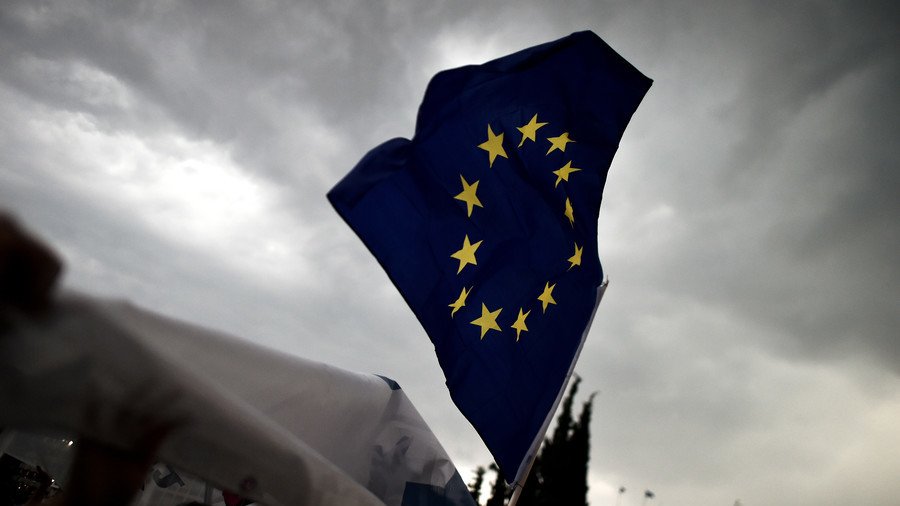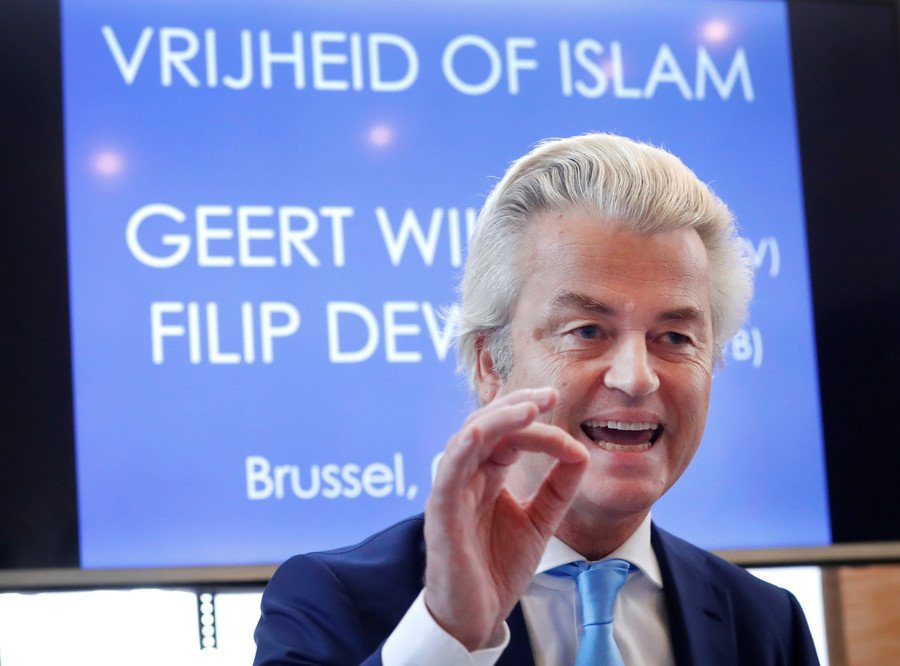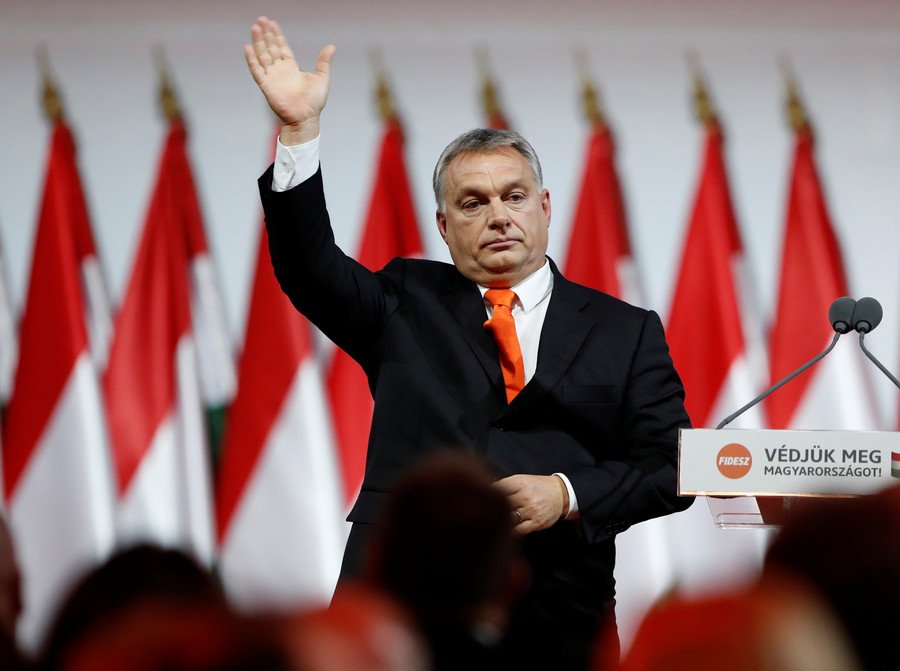Guide to the right: Where and how the right wing is rising in Europe

Italy has become the latest European country where a general election has brought about the rise of right-wing politicians. RT looks at a trend that’s growing across the EU.
The European Union is moving to the right side of the political spectrum. While left-wing officials, analysts and media blame anything from Russian bots to uneducated voters, the trend has been becoming more pronounced as elections take place across the bloc. Euroskeptic, anti-immigration and nationalist outlooks seem to be ever more appealing to the public.
To help you find your way in the changing political landscape, RT has put together a brief guide to the right-wing parties gaining clout in Europe: their agendas, leaders and the reasons of their success.
Italy
Italy voted on March 4, 2018 to elect lawmakers into both chambers of its parliament. At stake were the 630 seats in the lower Chamber of Deputies and 315 in the upper Senate. The result is projected to be a divided parliament, with a grand coalition necessary after immense gains for right-wing and anti-globalist forces.
The rising right
Lega (ex-Lega Nord) and Silvio Berlusconi’s Forza Italia pooled efforts in a center-right coalition that won about 37 percent of the vote for the lower house and 37.5 percent in the upper, to become the second-most powerful force in the Italian legislature.
With Italy on the receiving end of the overloaded cross-Mediterranean human smuggling routes, Lega’s anti-immigration message won it some 17.4 (17.6) percent, while the conservative Forza Italia and its controversial leader Silvio Berlusconi captured 14 (14.4) percent.

The Five Star Movement, which ended up the largest single party with over 32 percent in both chambers, sports a wider, “big tent” ideology, sharing the right coalition’s Euroskeptic tendencies.
The losers
This deals a powerful blow to Italy’s Democratic Party and its center-left following, which only mustered some 18.7 percent of support in the lower house and 19.2 percent in the upper. Stunned by the setback, the Democrats’ leader, former prime minister Matteo Renzi, announced his resignation.
UPDATE: Italy's Renzi confirms resignation as Democratic Party leader after election defeat https://t.co/7yDpZHIGw8pic.twitter.com/mpnJGenYdq
— RT (@RT_com) March 5, 2018
Austria
The October 15, 2017 election landed the Austrian government firmly in the hands of the right. Out of the 183 seats in the National Council, 113 ended up with the coalition lead by youngest-ever Chancellor Sebastian Kurz, who is 31 years old.
The rising right
Austrian People’s Party (OVP) was the biggest gainer with 31.5 percent of the vote. Kurz’s own charismatic image, his promises of tougher immigration control and a pushback against “political Islam” were enough to tip the balance, making the People’s Party the single largest in the Council. While previously governing in a grand coalition with the rival Social Democrats, its new-found clout is now united with the more hardline Freedom Party.
READ MORE: Freedom Party enters Austrian govt as anti-migrant sentiment creeps across Europe
The Freedom Party of Austria (FPO) is riding on a strong anti-immigration message, promising tighter border security in a country with one of Europe’s highest numbers of incoming asylum seekers per capita, and facing a sharp rise in crime by foreigners. It sealed 26 percent of the vote and a comfortable coalition partnership with Kurz’s OVP.

The losers
Number-on-number, the Social Democratic Party of Austria (SPO) suffered no loss (the Greens bore the brunt of that), gaining 0.1 percent compared to 2013 (which did not translate into additional seats). The enormous blow it suffered came from the loss of coalition partner OVP, who decided to abandon the SPO’s pro-European, leftist agenda, resulting in a sharp turn to the right for the Austrian government.
Gains and losses
- Austrian People’s Party (OVP): 62 seats (+15 from 2013)
- Freedom Party of Austria (FPO): 51 seats (+11 from 2013)
- Social Democratic Party of Austria (SPO): 52 seats (no change from 2013)
Germany
Germans went to the polls on September 24, 2017, to decide the composition of the 709-member Bundestag. What resulted was over five months without a government, as former allies drifted away from long-time Chancellor Angela Merkel and her liberal-conservative, pro-European Christian Democratic political alliance (CDU/CSU). The limbo eventually ended when the leftist Social Democratic Party (SPD) grudgingly agreed to re-enter a grand coalition with Merkel, paving the way for her fourth term as chancellor. Both parties were set back in the vote, however, resulting in gains for the right wing.
The rising right
Alternative for Germany (AfD), while by no means securing a majority, made a massive breakthrough, making it into the legislature for the first time. Its 12.6 percent (almost a threefold gain from 2013) came at the expense of CDU/CSU and SPD, as more Germans flocked to AfD’s anti-immigration, anti-Islamization, Euroskeptic agenda, disappointed by Merkel’s “open door” policy and the flood of asylum seekers it brought to the country.

The losers
While still emerging on top at the end of the day, both the CDU/CSU were hit hard. Merkel’s alliance ended up with 32.9 percent of the vote and the Social Democrats with 20.5 percent, each losing a fifth of its seats.
Gains and losses
- Alternative for Germany (AfD): 94 seats (+94 from 2013)
- CDU/CSU: 246 seats (-65 since 2013)
- Social Democratic Party (SPD): 153 seats (-40 since 2013)
The Netherlands
The 150-member Dutch House of Representatives ended up a pretty diverse place after the March 15, 2017 election. Right-wingers were among the biggest gainers, including the one-man party of hardline Euroskeptic Geert Wilders.
The rising right
The Party for Freedom (PVV), led by Geert Wilders, came in second with 13.1 percent of the vote at the expense of the People's Party for Freedom and Democracy (VVD), the center-right ruling party led by Prime Minister Mark Rutte. Like many in this list, Wilders is a staunch opponent of unhindered immigration, the growing influence of Islam in Europe, and the political clout the EU has over individual countries. Wilders’ support had flagged back in the 2012 election, but his message proved relevant enough when the European migrant crisis began in 2015, propelling him back up in the polls again.

The losers
The most striking loss hit the center-left Labor Party (PvdA), which, with only 5.7 percent support, suffered the biggest defeat in the history of Dutch elections. From second-largest party in 2012 it fell to near-obscurity with just nine seats.
READ MORE: Austria’s election results & their implications for Europe
Mark Rutte’s People's Party for Freedom and Democracy (VVD) was set back by about a fourth of its seats after two elections with solid gains, ending up with 21.3 percent and the PVV breathing down its neck.
Gains and losses
- Party for Freedom (PVV): 20 seats (+5 from 2012)
- People's Party for Freedom and Democracy (VVD): 33 seats (-8 from 2012)
- Labor Party (PvdA): 9 seats (-29 from 2012)
Hungary
The right wing has been in power in Hungary since Prime Minister Viktor Orban’s party Fidesz won a sweeping victory in 2010. The Hungarians are heading for a new poll in April 2018, and things are still looking good for the right.
The rising right
Fidesz – Hungarian Civic Alliance, Orban’s conservative, Euroskeptic party, actually dipped in popularity in 2014, falling from 2010’s stellar 52.73 percent to 44.87 percent. Opinion polls show that support for Fidesz had been flagging, falling to below 40 percent, until 2015 and the unprecedented influx of Middle Eastern refugees into Europe.

One of the most crowded land routes lay through Hungary, and Viktor Orban took a decidedly hardline stance against it, pushing back against EU-wide refugee quotas and building border barriers to limit illegal arrivals. This stance appeared to resonate well with the Hungarian public, resulting in a steady rise in Orban’s popularity. As of late February 2018, polls projected 52.9 percent in Fidesz’s favor – an even higher result than the 2010 landmark.
The losers
After the crushing defeat of 2010, the center-left, pro-European Hungarian Socialist Party (MSZP) scrambled to contest the 2014 vote, forming the Unity political alliance with four other liberal parties. Together, they only mustered 25.57 percent support, which was only a slight gain from what MSZP had achieved alone, and still almost 20 percent short of Fidesz. The alliance was soon disbanded. MSZP’s projections for 2018 look grim as well, with polls indicating under 12 percent support, and seven percent each for two of its closest-running Unity partners.
Gains and losses
Between the Unity’s brief existence and the 2012 constitutional reform, which cut the number of parliament seats in half, tracking changes in representation can be a challenge. Here are the 2014 numbers compared to 2010:
- Fidesz: 133 seats out of 199 (a decrease compared to 263/386 in 2010)
- Hungarian Socialist Party (MSZP): 58 seats out of 199 together with Unity partners (a gain compared to 59/386 in 2010, but that was as MSZP standing alone)
Poland
Poland switched over to the right in October 2015, when conservative Law and Justice (PiS) surged to defeat the Civic Platform, reversing the government-opposition balance. This ultimately resulted in a rift with the EU which could now cost Warsaw its European Parliament voting rights.
The rising right
Law and Justice (PiS) has been steadily gaining votes since its creation in 2001 by the brothers Kaczynski. In 2015 it swept to power with 37.58 percent of the vote, almost doubling its seats in the Polish Sejm from the 2011 numbers. Not only is the Polish Prime Minister, Mateusz Morawiecki, a PiS member, but the President Andrzej Duda also hails from the party (although he has been officially independent since his election in 2015), giving the right significant clout in deciding Poland’s course. Duda’s approval rating stands at whopping 72 percent. PiS is also enjoying a continued rise in popularity, with February 2018 polls projecting a 43 percent result in the next election.

PiS-led Poland has been fighting back against EU-enforced quotas on accepting refugees, only reluctantly agreeing to let in about half of the required number. It also earned the EU’s ire with a controversial 2017 judicial reform, which gives the parliament and the justice minister power to appoint Supreme Court judges. This has led to the European Commission initiating proceedings into stripping Poland of voting rights in the European Parliament. PiS leader Jaroslaw Kaczynski has slammed the movement as overreach and an intervention in Poland’s internal affairs.
The losers
The liberal, pro-EU Civic Platform (PO) won 24.09 percent of the vote in 2015, a whopping 15 percentage-point drop since 2011, neatly reversing positions with PiS and going into opposition. As of February 2018, its standing in opinion polls has slid even lower, dipping below 20 percent.
Gains and losses
- Law and Justice (PiS): 235 seats (+101 from 2011)
- Civic Platform (PO): 138 seats (-59 from 2011)
Sweden
Sweden has two right-leaning forces, both currently in opposition: The Alliance headed by the center-right Moderates party, and the much more pronounced Swedish Democrats, operating alone.
The rising right
Swedish Democrats bagged 12.9 percent of the 2014 vote, more than doubling its influence in the national legislature. They are pushing for economic and political independence from the European Union, but perhaps the most relevant part of their message is that Sweden must not accept any more immigrants. The country is home to the violent crime hotbed of Malmo and one of the highest sex crime rates in Europe, which some critics link to mass immigration. The Swedish government has acknowledged that its refugee-accepting capacity has hit its limit.

The losers
Sweden’s center-left ruling coalition, the Lofven Cabinet, is a minority government, with has 37.9 percent of popular backing across two parties. Their support remained virtually unchanged from 2010 to 2014. The Alliance, four parties with a combined 39.43 percent, lost about a fifth of its support. The Moderates, leading the alliance, have since abandoned their previously liberal stance on migration, calling for border controls, reduced welfare and stricter family reunification rules. They are now also floating the idea of uniting with the Swedish Democrats, previously shunned by other parties, to topple the minority government in the September 2018 election.
Gains and losses
- Swedish Democrats: 49 seats (+29 from 2010)
- Lofven Cabinet: 138 seats (+1 from 2010)
- Moderates: 141 seats (-32 from 2010)
Switzerland
Switzerland last elected its 200-seat National Council and 46-seat Council of States in October 2015. The vote resulted in gains for both of the country’s right-leaning forces: the center-right Liberals and the more hardline People’s Party.
The rising right
Swiss People’s Party won 29.4 percent of the votes, breaking a 50-year record for the number of National Council seats held by any one party. Its key message includes a reduction of involvement in international blocs including the EU and NATO, and tougher immigration controls.

The Liberals gained 16.4 percent, landing the third-largest representation. While standing for the integration of immigrants, they are opposed to Switzerland’s EU membership, instead supporting individual, two-sided agreements.
The losers
No single party suffered a dramatic setback – the 2015 vote chipped away a little at all of them except the right-wing nationalist People’s Party (SVP/UDC) and the conservative liberal Free Democratic Party (FDP). Their main rival, the left-wing Social Democrats, managed not to lose too much ground, remaining in second spot with 18.8 percent and only surrendering two seats.
Gains and losses
- Swiss People’s Party: 70 seats (+11 from 2011)
- FDP.The Liberals: 46 seats (+4 from 2011)
- Social Democrats: 55 seats (-2 from 2011)
Denmark
Denmark’s 2015 general election witnessed the biggest rise for the country’s most right-wing party, and the biggest fall for the minority ruling party.
The rising right
The Danish People’s Party came in second with 21.1 percent of the vote, almost doubling its presence in the legislation. Its policies include preserving the Danish national identity by limiting multiculturalism and assimilating non-Western migrants. It wants Denmark to keep its own national currency and preserve its sovereignty from overreaching EU power.

The losers
The biggest loss was suffered by Venstre, the centerpiece of the ruling center-right coalition of Denmark. It came in third with 19.5 percent.
The center-left Social Democrats remained in opposition despite gaining the most votes at 26.3 percent.
Gains and losses
- Danish People’s Party: 37 seats (+15 from 2011)
- Social Democrats: 47 seats (+3 from 2011)
- Venstre: 34 seats (-13 from 2011)
France
France differs from the rest of this list in that the right wing failed to make significant gains in the legislature in the 2017 vote. Instead, the same year’s presidential election brought to prominence a singular right-wing politician.
The rising right
Marine le Pen, the notorious leader of the hardcore right-wing National Front, ran for president in April and May 2017. Her agenda combined all of the staples of the European right, including Euroskepticism, economic nationalism, and anti-immigration. She outraged the liberal media by meeting with Russian President Vladimir Putin at a time when Moscow remains the West’s go-to bogeyman.

In spite of all these factors, or perhaps thanks to them, Le Pen secured over 21 percent of the vote in the first round, right behind Emmanuel Macron and his 24 percent. Both proceeded to the run-off, where Macron managed to beat Le Pen with the consolidated backing of 66.1 percent against 33.9 percent. While not a victory in itself, it certainly sent a message: right-wing sentiment is creeping across Europe, upheaving the political landscape.
Think your friends would be interested? Share this story!















